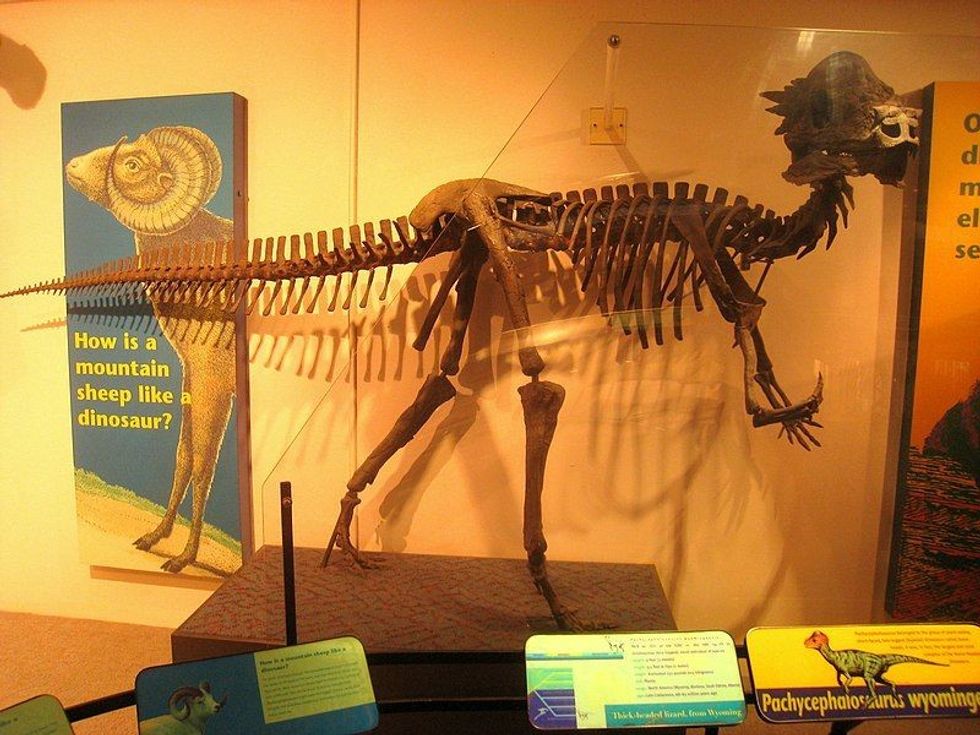The Pachysaurus, also known commonly by the name Pachycephalosaurus, was a bipedal herbivorous dinosaur that lived in the Late Cretaceous period, 65 million years ago, in western North America. Its fossils have been found in Montana, South Dakota, Wyoming, and Alberta. The fossils have currently been donated to a museum for display.
The name Pachycephalosaurus is Greek for 'thick-headed lizard'. The animal has a domed skull that is 9-10 in (22-25 cm) thick and is lined with spiky knobs.
It had two feet and two hands. The hind limbs were longer and stronger than the front limbs. It reproduced by laying eggs.
If you liked reading about the Pachycephalosaurus, also see interesting facts about Rahonavis and Zigongosaurus.
Pachysaurus Interesting Facts
How do you pronounce 'Pachysaurus'?
The name 'Pachysaurus' is pronounced as 'pack-i-sore-russ' and the more popular name Pachycephalosaurus is pronounced as 'pack-i-sef-al-oh-sore-russ'.
What type of dinosaur was a Pachysaurus?
The Pachycephalosaurus was a bipedal Pachycephalosaurid dinosaur. It was a non-avian or terrestrial dinosaur. It was known for its distinctly thick and domed head.
In which geological period did the Pachysaurus roam the Earth?
The Pachycephalosaurus lived on Earth during the Triassic, Jurassic, and Cretaceous periods.
When did the Pachysaurus become extinct?
It lived around 70 million years ago in the Late Cretaceous period before the Cretaceous-Paleogene mass extinction event 65 million years ago.
Where did Pachysaurus live?
This Jurassic period dinosaur Pachycephalosaurus lived in the western part of modern-day North America. The fossil specimen of this dinosaur was found in Montana, South Dakota, Wyoming, and Alberta.
The first fossil found was a bone fragment found close to the Missouri River in 1860. The fossil was found in Hell Creek Formation and Lance Formation and was later displayed in a museum.
What was the Pachysaurus' habitat?
The Pachycephalosaurus inhabited grassy green habitats with an abundance of vegetation. It lived in areas like grasslands, forests, woodlands, or plains.
Who did Pachysaurus live with?
The Pachycephalosaurus dinosaur lived in herds with conspecifics and other dinosaur species too. Pachycephalosaurus also lived in a close group, similar to goats and sheep, with other pachycephalosaur species and Dracorex and Stygimoloch; which might be the juveniles of Pachycephalosaurus.
How long did a Pachysaurus live?
The exact age or lifespan of the Pachycephalosaurus has not been discovered yet. Two fossils found in the same area as the Pachycephalosaurus were named Dracorex hogwartsia and Stygimoloch spinifer.
Modern data gave new evidence that proved they were not fossils of a different dinosaur but instead were the fossils of the Pachycephalosaurus at different life stages. The Dracorex fossil was a juvenile and the Stygimoloch a sub-adult.
How did they reproduce?
The Pachysaurus probably had a fixed breeding season and were oviparous like other dinosaurs. Pachycephalosaurus laid eggs after internal fertilization took place post-breeding.
The juveniles then would hatch from the eggs after an incubation period which differed depending on species. Fossils of their eggs have not been found yet, thus very little data is available on the reproduction of Pachycephalosaurus.
Pachysaurus Fun Facts
What did the Pachysaurus look like?

The most distinctive feature of a Pachycephalosaurus is its large, bony dome on the skull. The skull is nearly 10 in (25 cm) thick.
Considering the thickness of its solid dome-shaped skull, its brain was probably very small, but well protected nonetheless. The dinosaur had a short snout and the thick skull dome was lined with small upward protecting bony knobs and short bony spikes.
This dinosaur's eyes faced forward, proven by the short skull having large, rounded forward-facing eye sockets.
Dinosaurs with this type of eye socket could usually see well and have binocular vision. The small snout of the Pachycephalosaurus ended in a pointed beak that held their tiny teeth with leaf-shaped crowns.
The neck was moderate in length and was either S-shaped or U-shaped. Juveniles of the Pachycephalosaurus might have had a much flatter skull and larger spikes projecting out of the back of the skull.
As the dinosaur grew in age the hoards shrunk while the dome got rounded out.
It is also possible that the knobs got absorbed into the skull mass, which helped it grow larger and more rounded in the sub-adults and adults at a later life stage.
The anatomy of the Pachycephalosaurus, in particular, is not known in detail but based on other related dinosaurs from its family, it probably had a short, thick neck, short forelimbs, bulky body, long and powerful hind legs, and a heavy tail.
It had two legs and feet, two arms, three toes, and five fingers. Only two out of three toes on their feet touched the ground.
How many bones did a Pachysaurus have?
The exact number of bones in the Pachycephalosaurus dinosaur is not known because no full specimen has been found. The first fossil remains ever found on site was a bone fragment, consequently larger portions of the skeleton have been found close to the Missouri River.
Complete head fossils have been found in recent years which helped scientists confirm the classification of the dinosaur.
How did they communicate?
Like other dinosaur groups, it can be assumed that the Pachycephalosaurus dinosaur communicated using their thick rounded skulls, body, and vocalization. Dinosaurs could create loud open-mouthed sounds and closed-mouthed sounds.
The close-mouthed sounds of a lower frequency could travel long distances, which helped them communicate with the rest of the herd or warn rivals of their territory.
The dinosaur group used its bone-headed skull during mating rituals to choose and impress mates, to scare rival dinosaurs, or to dominate other dinosaurs in the herd. The Pachycephalosaurus, in particular, used it for head-butting.
How big was the Pachysaurus?
The Pachysaurus size was 14.8 ft (4.5 m) in length and 4 ft (1.2 m) tall. The Pachycephalosaurus was more than seven times larger than an English Shepherd and four to five times larger than a wild goat.
How fast could a Pachysaurus move?
The Pachycephalosaurus could run quite fast and could be considered agile even with its large size. It was a bipedal dinosaur that traveled by using its hind legs. The legs ended with three toes, of which two touched the ground. Their front limbs had five fingers. The Pachycephalosaurus' hind legs were much stronger and muscular than their front limbs.
How much did a Pachysaurus weigh?
The Pachycephalosaurus weighed 990 lb (449.05 kg). Almost the same as an Arabian stallion.
What were the male and female names of the species?
This thick-headed Pachycephalosaurus doesn't have sex-specific names for males and females. While many dinosaurs exhibit sexual dimorphism, it remains unclear whether the Pachycephalosaurus does.
What would you call a baby Pachysaurus?
The baby Pachycephalosaurus does not have any particular name. Depending on the life stage of Pachycephalosaurus it can be called juvenile, sub-adult, or adult. The juveniles are also called babies or hatchlings.
What did they eat?
Researchers think that the Pachycephalosaurus dinosaur was herbivorous because it had small teeth which could not have chewed or torn any raw meat or hard food. This herbivorous dinosaur's diet would probably include plants, fruits, seeds, and insects. Its teeth were very similar to that of a Stegoceras.
How aggressive were they?
The Pachycephalosaurus' head fossils from approximately 65 million years ago had evidence of blunt force trauma, scientists concluded that they would butt heads together while fighting. The Pachycephalosaurus may have had both offensive and defensive tactics as they would butt head with rivals to assert dominance and also run from larger carnivorous animals.
The short knobs on their heads may have had defensive uses.
Since their necks would be U-shaped or S-shaped they couldn't be straightened to hit another animal or to ram their heads together very effectively. They may also possibly practice flank butting.
Did you know...
The Pachycephalosaurus wyomingensis is the only species in the Pachycephalosaurus genus and it is the largest-known Pachycephalosaur dinosaur.
The Micropachycephalosaurus, a close relative of Pachycephalosaurus, is one of the smallest known dinosaurs in the world and lived in the Late Cretaceous period, 65 million years ago. Ironically it has the longest dinosaur name in the world.
The Pachycephalosaurus and the Tyrannosaurus both lived during the Late Cretaceous period in western North America. It is possible that the carnivorous Tyrannosaurus Rex would prey on the Pachycephalosaurus.
The name Dracorex hogwartsia was inspired by the Harry Potter series written by J.K. Rowling.
The skull of a Pachycephalosaurus was 30 times thicker than a human skull.
Why are they called Pachysaurus?
In Greek, pachys means 'thick', kephale means 'head', and sauros means 'lizard'. The full name Pachycephalosaurus means 'thick-headed lizard'.
Who discovered Pachysaurus?
The first Pachycephalosaurus bone fragment was found on-site by Ferdinand Vandeveer Hayden in 1860. Pachycephalosaurus wyomingensis was named by Charles W. Gilmore, for a partial skull found in Wyoming. In 1943, Barnum Brown and Erich Maren Schlaikjer found a nearly complete skull from the Hell Creek Formation site in Montana.
Here at Kidadl, we have carefully created lots of interesting family-friendly dinosaur facts for everyone to discover! For more relatable content, check out these Tylocephale facts and Draconyx facts for kids.
You can even occupy yourself at home by coloring in one of our free printable Pachysaurus coloring pages.









